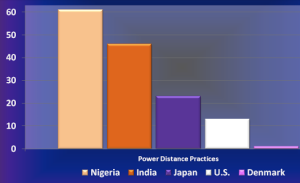This dimension refers to the degree to which members of a group expect and agree that power should be shared unequally. Power distance is concerned with the way cultures are stratified, thus creating levels between people based on power, authority, prestige, status, wealth, and material possessions.
| HIGH UNCERTAINTY AVOIDANCE societies’ characteristics | LOW UNCERTAINTY AVOIDANCE societies’ characteristics |
|
|
- VALUES AND PRACTICESAccounting for all 61 societies, the average score for power distance practices (“as is”) was 5.17 on the 1-to-7 scales, while the average for power distance values (“should be”) was a hugely different 2.75. Clearly, middle managers worldwide perceive themselves, as working in a situation in which there’s a substantial gap in status and power between themselves and their supervisors.
- Table 2: GLOBE's Power Distance Practices (Rank)
As shown in table 2 above, the U.S and Denmark are placed among the lower power distance practices countries.
- Power DistancePower distance practices for the U.S were evaluated at 4.88 by American middle managers, while power distance values were evaluated at 2.85, which are considered a low score for power distance.
- APPLICATION TO LEADERSHIPPower distance did show a strong positive relationship with Self-Protective leadership. The authors added, “The high power distance values and practices of Asian societies are often associated with face-saving and status-consciousness, both of which are elements of the Self-Protective leadership dimension”.
NOTE: Societies that highly value POWER DISTANCE strongly associate the following global leader behavior (CLT) with outstanding leadership: SELF-PROTECTIVE
Source :
Grove C.N. (2005). Introduction to the GLOBE Research Project on Leadership Worldwide. http://www.grovewell.com/pub-GLOBE-intro.html
Grove C.N. (2005). Worldwide Differences in Business Values and Practices: Overview of GLOBE Research Findings. http://www.grovewell.com/pub-GLOBE-dimensions.html
House et al (2004). Culture, Leadership, and Organizations: The GLOBE Study of 62 Societies. Thousand Oaks, CA: Sage, 17.2, p. 536.

No comments:
Post a Comment